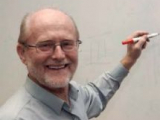A large family of two-dimensional transition metal carbides and nitrides (MXenes) raises interest for many applications due to their high electrical conductivity, mechanical properties, potentially tunable electronic structure, nonlinear optical properties, and the ability to be manufactured in the thin film state. However, their chemistry that is key to development of these applications, still remains largely terra incognita. In this presentation we will discuss recent progress in understanding MXene chemistry and harnessing it for development of applications.
...
You are here
Seminars
Thursday, 16.01.2020 10:00
Associate Professor Vadym Mochalin (Department of Chemistry and Department of Materials Science & Engineering Missouri University of Science & Technology, Rolla, MO 65409, USA)
Thursday, 16.01.2020 11:00
Associate Professor Vadym Mochalin (Department of Chemistry and Department of Materials Science & Engineering Missouri University of Science & Technology, Rolla, MO 65409, USA)
Nanomaterials hold tremendous potential enabling new unexpected applications and pushing the horizons of attainable properties and environments amenable to exploration to the extreme limits. Graphene (2D), carbon nanotubes (1D), and fullerene (0D) are commonly known, but the nanomaterials world has many more treasures to offer. The talk will give an overview and discuss our recent progress in nanodiamond (0D sp3 carbon).
Nanodiamond powder made of ~5nm diamond particles with large accessible surface and tailorable surface chemistry delivers extreme...
Tuesday, 21.01.2020 14:00
Sang Hyun Park (Korea Institute of Energy Research, Republic of Korea)
After the single-crystal thermoelectric SnSe results which showed high figure of merit of 2.6 in 2014 [1], many studies on high temperature thermoelectric materials were followed for a practical application of thermoelectric power generation [2,3]. Despite of the development of these materials, there have been few high temperature thermoelectric devices reported so far, due to the lack of proper metallization technique that can make good electrical and thermal contact at the electrode interfaces.
In this talk, several approaches KIER has been chased to fabricate high temperature...
Wednesday, 29.01.2020 14:00
Harold Erbin (University of Turin)
Abstract: Machine learning has revolutionized most fields it has penetrated, and the range of its applications is growing rapidly. The last years has seen efforts towards bringing the tools of machine learning to lattice QFT. After giving a general idea of what is machine learning, I will present two recent results on lattice QFT: 1) computing the Casimir energy for a 3d QFT with arbitrary Dirichlet boundary conditions, 2) predicting the critical temperature of the confinement phase transition in 2+1 QED at different lattice sizes.
Thursday, 30.01.2020 16:00
Tomáš Ledvinka (Charles University, Prague)
Abstract: Despite the tremendous success of mathematical general relativity which revealed among others surprising features of the geometry of rotating (Kerr) black holes and developed approximation techniques to study early stages of their inspiral, the necessity to describe completely the merger of two black holes lead to a substantial progress of numerical relativity. This field necessarily uses techniques of modern computer science to amass and command number crunching capabilities of current computers as well as numerical methods for partial differential equations, but the successful...
Monday, 17.02.2020 11:00
Aleš Hrabec (ETH Zurich & Paul Scherrer Institut, Switzerland)
Magnetically coupled nanomagnets have many potential applications. In order to realize functional two-dimensional networks of coupled nanoscale magnetic elements, it is desirable to engineer effective lateral magnetic couplings in a controllable way. I will show that we are able to develop a method to control the lateral coupling between adjacent magnetic nanostructures based on the interfacial Dzyaloshinskii-Moriya interaction (DMI). We have patterned regions with in-plane (IP) and out-of-plane (OOP) magnetic anisotropy in a magnetic element using selective oxidation of Pt/Co/Al films, and the magnetization in the OOP and IP parts of the islands are coupled via DMI arising from the Pt underlayer. This results in chirally coupled magnetization. We have exploited this concept for various applications.
Past seminars
Pages
Short news
Institute and media
Velké významné infrastruktury, 22.11.2019.
This year marks the...
Uniwersytet Opolski 21.10.2019.
J. Krása (Institute of Physics...
Ferroelectrics, 11.2.2019.
It is with much pleasure that I...
Technologické centrum AV ČR, 11.10.2018.
Czech Liaison Office...

